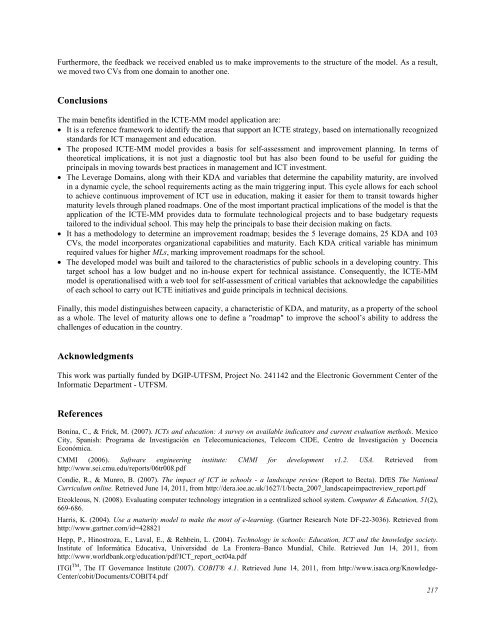A Maturity Model for Assessing the Use of ICT in School Education
A Maturity Model for Assessing the Use of ICT in School Education
A Maturity Model for Assessing the Use of ICT in School Education
You also want an ePaper? Increase the reach of your titles
YUMPU automatically turns print PDFs into web optimized ePapers that Google loves.
Fur<strong>the</strong>rmore, <strong>the</strong> feedback we received enabled us to make improvements to <strong>the</strong> structure <strong>of</strong> <strong>the</strong> model. As a result,<br />
we moved two CVs from one doma<strong>in</strong> to ano<strong>the</strong>r one.<br />
Conclusions<br />
The ma<strong>in</strong> benefits identified <strong>in</strong> <strong>the</strong> <strong>ICT</strong>E-MM model application are:<br />
It is a reference framework to identify <strong>the</strong> areas that support an <strong>ICT</strong>E strategy, based on <strong>in</strong>ternationally recognized<br />
standards <strong>for</strong> <strong>ICT</strong> management and education.<br />
The proposed <strong>ICT</strong>E-MM model provides a basis <strong>for</strong> self-assessment and improvement plann<strong>in</strong>g. In terms <strong>of</strong><br />
<strong>the</strong>oretical implications, it is not just a diagnostic tool but has also been found to be useful <strong>for</strong> guid<strong>in</strong>g <strong>the</strong><br />
pr<strong>in</strong>cipals <strong>in</strong> mov<strong>in</strong>g towards best practices <strong>in</strong> management and <strong>ICT</strong> <strong>in</strong>vestment.<br />
The Leverage Doma<strong>in</strong>s, along with <strong>the</strong>ir KDA and variables that determ<strong>in</strong>e <strong>the</strong> capability maturity, are <strong>in</strong>volved<br />
<strong>in</strong> a dynamic cycle, <strong>the</strong> school requirements act<strong>in</strong>g as <strong>the</strong> ma<strong>in</strong> trigger<strong>in</strong>g <strong>in</strong>put. This cycle allows <strong>for</strong> each school<br />
to achieve cont<strong>in</strong>uous improvement <strong>of</strong> <strong>ICT</strong> use <strong>in</strong> education, mak<strong>in</strong>g it easier <strong>for</strong> <strong>the</strong>m to transit towards higher<br />
maturity levels through planed roadmaps. One <strong>of</strong> <strong>the</strong> most important practical implications <strong>of</strong> <strong>the</strong> model is that <strong>the</strong><br />
application <strong>of</strong> <strong>the</strong> <strong>ICT</strong>E-MM provides data to <strong>for</strong>mulate technological projects and to base budgetary requests<br />
tailored to <strong>the</strong> <strong>in</strong>dividual school. This may help <strong>the</strong> pr<strong>in</strong>cipals to base <strong>the</strong>ir decision mak<strong>in</strong>g on facts.<br />
It has a methodology to determ<strong>in</strong>e an improvement roadmap; besides <strong>the</strong> 5 leverage doma<strong>in</strong>s, 25 KDA and 103<br />
CVs, <strong>the</strong> model <strong>in</strong>corporates organizational capabilities and maturity. Each KDA critical variable has m<strong>in</strong>imum<br />
required values <strong>for</strong> higher MLs, mark<strong>in</strong>g improvement roadmaps <strong>for</strong> <strong>the</strong> school.<br />
The developed model was built and tailored to <strong>the</strong> characteristics <strong>of</strong> public schools <strong>in</strong> a develop<strong>in</strong>g country. This<br />
target school has a low budget and no <strong>in</strong>-house expert <strong>for</strong> technical assistance. Consequently, <strong>the</strong> <strong>ICT</strong>E-MM<br />
model is operationalised with a web tool <strong>for</strong> self-assessment <strong>of</strong> critical variables that acknowledge <strong>the</strong> capabilities<br />
<strong>of</strong> each school to carry out <strong>ICT</strong>E <strong>in</strong>itiatives and guide pr<strong>in</strong>cipals <strong>in</strong> technical decisions.<br />
F<strong>in</strong>ally, this model dist<strong>in</strong>guishes between capacity, a characteristic <strong>of</strong> KDA, and maturity, as a property <strong>of</strong> <strong>the</strong> school<br />
as a whole. The level <strong>of</strong> maturity allows one to def<strong>in</strong>e a "roadmap" to improve <strong>the</strong> school’s ability to address <strong>the</strong><br />
challenges <strong>of</strong> education <strong>in</strong> <strong>the</strong> country.<br />
Acknowledgments<br />
This work was partially funded by DGIP-UTFSM, Project No. 241142 and <strong>the</strong> Electronic Government Center <strong>of</strong> <strong>the</strong><br />
In<strong>for</strong>matic Department - UTFSM.<br />
References<br />
Bon<strong>in</strong>a, C., & Frick, M. (2007). <strong>ICT</strong>s and education: A survey on available <strong>in</strong>dicators and current evaluation methods. Mexico<br />
City, Spanish: Programa de Investigaciòn en Telecomunicaciones, Telecom CIDE, Centro de Investigaciòn y Docencia<br />
Económica.<br />
CMMI (2006). S<strong>of</strong>tware eng<strong>in</strong>eer<strong>in</strong>g <strong>in</strong>stitute: CMMI <strong>for</strong> development v1.2. USA. Retrieved from<br />
http://www.sei.cmu.edu/reports/06tr008.pdf<br />
Condie, R., & Munro, B. (2007). The impact <strong>of</strong> <strong>ICT</strong> <strong>in</strong> schools - a landscape review (Report to Becta). DfES The National<br />
Curriculum onl<strong>in</strong>e. Retrieved June 14, 2011, from http://dera.ioe.ac.uk/1627/1/becta_2007_landscapeimpactreview_report.pdf<br />
Eteokleous, N. (2008). Evaluat<strong>in</strong>g computer technology <strong>in</strong>tegration <strong>in</strong> a centralized school system. Computer & <strong>Education</strong>, 51(2),<br />
669-686.<br />
Harris, K. (2004). <strong>Use</strong> a maturity model to make <strong>the</strong> most <strong>of</strong> e-learn<strong>in</strong>g. (Gartner Research Note DF-22-3036). Retrieved from<br />
http://www.gartner.com/id=428821<br />
Hepp, P., H<strong>in</strong>ostroza, E., Laval, E., & Rehbe<strong>in</strong>, L. (2004). Technology <strong>in</strong> schools: <strong>Education</strong>, <strong>ICT</strong> and <strong>the</strong> knowledge society.<br />
Institute <strong>of</strong> In<strong>for</strong>mática Educativa, Universidad de La Frontera–Banco Mundial, Chile. Retrieved Jun 14, 2011, from<br />
http://www.worldbank.org/education/pdf/<strong>ICT</strong>_report_oct04a.pdf<br />
ITGI TM , The IT Governance Institute (2007). COBIT® 4.1. Retrieved June 14, 2011, from http://www.isaca.org/Knowledge-<br />
Center/cobit/Documents/COBIT4.pdf<br />
217
















